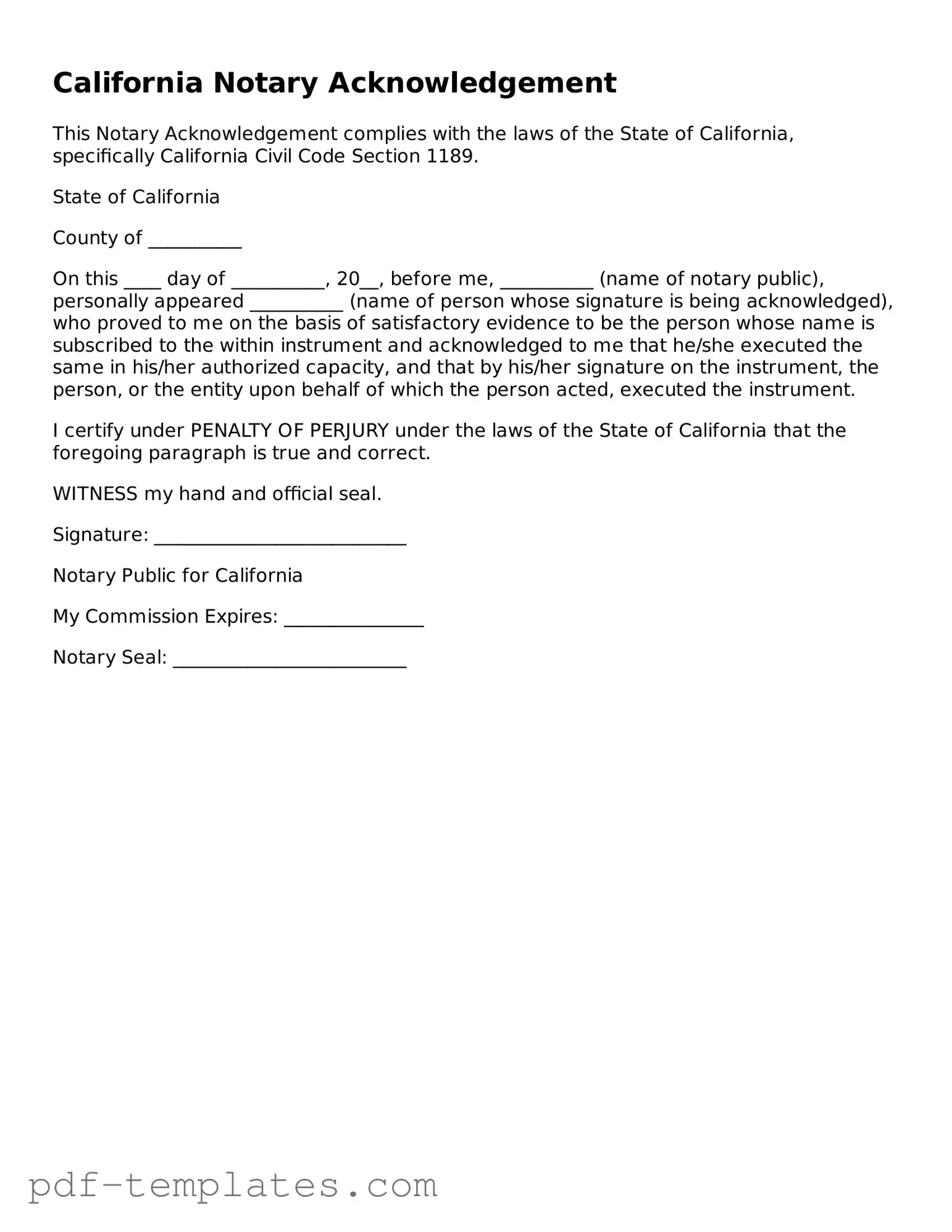The California Notary Acknowledgment form is similar to the Affidavit of Identity. Both documents serve to verify the identity of individuals involved in a legal transaction. An Affidavit of Identity is often used when a person needs to confirm their identity for various purposes, such as opening a bank account or signing legal documents. Just like the Notary Acknowledgment, this affidavit requires a signature and may need to be notarized to ensure its authenticity. The main difference lies in the context in which each document is used, but both aim to protect against fraud by confirming the identity of the signer.
Another document that shares similarities with the California Notary Acknowledgment is the Power of Attorney. A Power of Attorney grants someone the authority to act on behalf of another person in legal or financial matters. Like the Notary Acknowledgment, it often requires notarization to ensure that the principal’s consent is genuine. Both documents require the signature of the individual granting authority or acknowledgment, thus providing a layer of protection against unauthorized actions. While the Notary Acknowledgment focuses on confirming the signing of a document, the Power of Attorney empowers another individual to make decisions on behalf of the signer.
The Deed of Trust also bears resemblance to the Notary Acknowledgment. This legal document is used in real estate transactions to secure a loan with real property. Notarization is typically required for a Deed of Trust to ensure that the signatures on the document are valid and that all parties involved understand their obligations. Both documents serve to formalize agreements and protect the interests of the parties involved. The Deed of Trust, however, specifically relates to financial transactions and property rights, whereas the Notary Acknowledgment can apply to a broader range of documents.
Similar to the Notary Acknowledgment, the Certification of Acknowledgment is another document that verifies the identity of a signer. This certification is often used in various legal contexts to confirm that a person has signed a document willingly and understands its content. Both forms require the notary to witness the signing and confirm the identity of the signer. While the Notary Acknowledgment is a specific form used in California, the Certification of Acknowledgment can be used in different jurisdictions, providing a similar function of ensuring authenticity in the signing process.
The Jurat is another document that shares characteristics with the Notary Acknowledgment. A Jurat is used when a signer must swear or affirm the truth of the contents of a document. Like the Notary Acknowledgment, a Jurat requires the presence of a notary, who verifies the identity of the signer and witnesses the signing. The key distinction is that a Jurat involves an oath or affirmation regarding the truthfulness of the document, while the Notary Acknowledgment focuses on confirming the act of signing itself. Both documents are essential in legal contexts to ensure the integrity of the information presented.
Understanding the various legal documentation processes is essential, especially when navigating through forms such as the Request for Authorization for Medical Treatment (DWC Form RFA), which plays a crucial role in the California Division of Workers’ Compensation system. For comprehensive resources regarding essential paperwork within this realm, including the RFA form, you can refer to All California Forms. These forms facilitate the submission of medical requests critical for injured employees, underpinning the importance of having all necessary documentation in order.
Lastly, the Statutory Declaration is similar to the Notary Acknowledgment in that it serves to affirm the truth of certain facts in a legal context. A Statutory Declaration is a written statement made under oath, often used in situations where a formal affidavit is not required. Like the Notary Acknowledgment, this document typically requires notarization to validate the identity of the declarant. Both documents aim to provide assurance that the information contained within is truthful and accurate, thereby preventing potential disputes or misunderstandings in legal matters.
